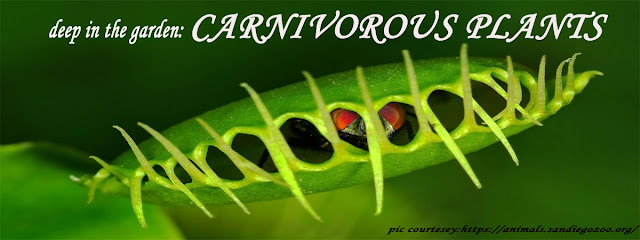deep in the Garden: CARNIVOROUS PLANTS
One of my favourite thing is to explore and roaming around with the plants to locate all the enchanting varieties growing throughout the sphere. Over the years, I have come across some lovely distinctive stuff—but few things seize our observation like the wonderful queerness of carnivorous plants/wild plants. Now the trend has changed of keeping these Carnivorous plants as indoor plants/domestic plants with undue care.
Carnivorous plant, sometimes called insectivorous plant, any plant particularly tailored for shooting and digesting insects and different small bugs and animals by the use of creative pitfalls and traps. Carnivory in plants has evolved independently about six instances across several families and orders. The more than 600 known species of carnivorous plants represent an excessively diverse team, in some instances having little extra in not unusual than their carnivorous addiction.
While they still use photosynthesis like their green brothers and sisters, carnivorous plants complement their diets with meat to get the nutrition they need. Most devour bugs, however some greater ones actually consume animals including mice, birds, and fish. Luckily, the majority of the nearly 600 species of carnivorous plants are relatively small—and contrary to a few famous Hollywood motion pictures, none of them devour humans!
So how do carnivorous plants catch their meals?
The first step is attracting a prey. Carnivorous plants do this mostly via colours, nectars, and scents—however some even glow at midnight to get their prey’s attention. Once the possible meal is in the plot, they spring their entice.
They execute with one of 5 strategies, together with:
§ Snap traps: Leaves open and snap closed rapidly round the unsuspecting prey.
§Pitfall traps: A pitcher-shaped leaf traps food that falls into it.
§Lobster-pot traps: The plant has openings permitting prey to get in, then crushes it with bristles or hairs.
§Flypaper traps: A sticky fluid substance is secreted to seize small bugs on leaves.
§ Bladder traps: A bladder pulls the meal within the plant and traps it with water.
Once a carnivorous plant has captured its food, it most often digests it with enzymes over the course of a couple of days. But some types like pitcher plants, additionally use microorganism to wreck down the meal, which is helping the plant to absorb extra vitamins. Either method, carnivorous plants don’t if truth be told bite meals; they only lure it to be digested later.
Where we develop these plants?
Some carnivorous plants are simple to search out in certain parts of the arena, however others may also be extraordinarily rare. While they arrive in all other shapes and sizes, they do share some commonplace traits, together with liking highly regarded, humid, and rainy environments. This makes them neatly suited for are living in the world’s rain forests, particularly in South America and Asia. But many reside in additional temperate spaces, including the Venus flytrap, which is native to both North and South Carolina.
Unlike most crops, carnivorous plants most often do neatly in nutrient-poor soil, which is why they complement their diet with meat. This makes spaces near bogs an excellent location for them, as competition from different plants is low because of deficient soil quality.
While that is standard, one notable exception is sundew plants, which develop in bright, arid fields and lure bugs with sticky residue.
How can I expand my own?
Carnivorous plants are too tricky to handle. Since many sorts are tricky or just about unattainable to boost outside their herbal habitats, we propose starting with a Venus flytrap, which is affordable and will also be discovered at maximum garden and lawn shops.
Luckily, they’re simple to maintain as an indoor plant if you apply those useful guidelines:
§ Make certain the soil/rising medium you’re the use of is low in nutrients and has just right drainage.
§Even though it’s tempting, don’t touch the “mouth” of the plant to trigger the entice. This can harm it.
§Grow the plant in a small terrarium, as this allows you to feed it dwelling flies. Keep in mind Venus flytraps gained to eat a dead fly.
§Only feed your plant small flies as soon as each and every couple of weeks. Don’t use every other food.
§Give the plant plentiful daylight, and stay soil wet. Carnivorous crops are simply one more reason we find the world of crops so attention-grabbing.
Drosera capensis, the Cape sundew: one of the prettiestand most entertaining sundews, this species is also one of the adaptable. An Excellent fly catcher and a really perfect plant for brand spanking new growers. It’s amazing how they’ve adapted to capture prey, and we will be able to wait to look what sorts of new carnivorous plant horticulturalists will discover subsequent!
Buy best from respected sources to keep away from fooling you in the selection of wild seed.
Thanks for reading!




terrarium is a nice concept, it looks soo pretty
ReplyDelete